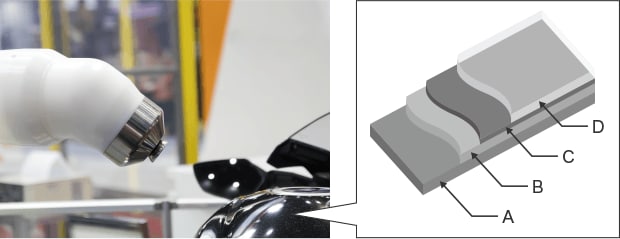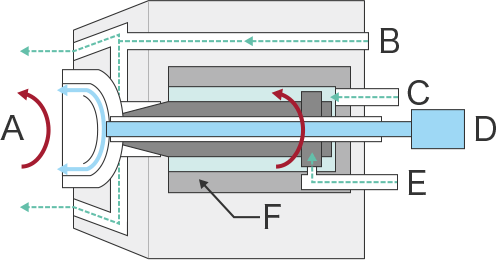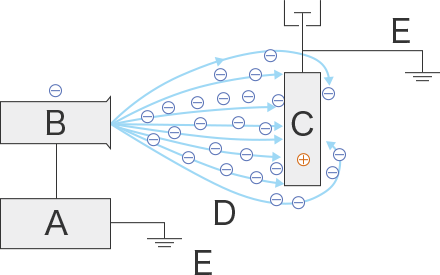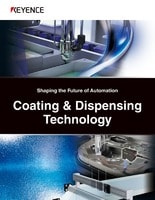Robot Painting
Overview of painting robots
Painting robot systems have been increasingly introduced in FA (factory automation) painting processes, including in the automotive industry. Continued development has achieved even greater automation and improved efficiency.
- Film forming in car body painting
-

- A. Electrodeposition (rust prevention)
- B. Middle coat (chipping prevention)
- C. Base coat (coloring)
- D. Clear coat (durability, finish)
A typical application of painting robots is the painting of exterior body panels of cars. The purpose of such painting processes is not limited to design only. The process usually consists of electrodeposition for rust prevention, a middle coating for preventing the exposure of base steel due to impacts from stones or chipping, a base coat for coloring, and a clear coat for durability, such as for surface protection and weather resistance.
In most cases, the electrodeposition process uses dip coating (immersion), but other painting processes adopt electrostatic painting using a rotary atomization system by painting robots.
Rotary atomization system mechanism
- Example of a rotary atomization system
-

- Bell cup
- Shaping air
- Bearing air
- Feed tube (paint)
- Turbine air
- Air motor
A rotary atomization system is a mechanism that broadens the coating pattern while converting the paint into a fine mist. These systems are used for electrostatic painting with painting robots.
The air motor is rotated at a high speed to convert the air for turbine rotation into a layer of air between the axis and the bearing. The bearing air is used to make this mechanism rotate at high speed without contact. The paint is converted into a fine mist by the rotation and sent in the direction of the target due to the air pressure of the shaping air.
Electrostatic painting mechanism
- Example of electrostatic painting equipment
-

- High-voltage generator
- Spray gun (rotary atomization system)
- Target (workpiece)
- Mist of paint
- Grounding
A grounded target is set on the positive side while the paint spraying equipment is set on the negative side. When a high DC voltage (70 K to 100 KV) is applied, the mist of paint becomes negatively charged and adheres to the positively-charged target.
This painting method can significantly reduce paint loss and time spent painting, as well as provide many other advantages such as reduced pollution and improved work environments.
In addition to rotary atomization systems, painting guns also work with electrostatic atomization systems that use an electrostatic force to change the paint into fine drops. These systems are widely used for painting mass-produced industrial products such as car and motorbike bodies, rmetal components, railroad cars, electrical products, steel office equipment, and housing parts.
Present state of painting robots
The need to achieve even, uniform painting on complicated shapes or intricate sections such as car bodies and components has attracted individuals with sufficient expertise and experience. Stable painting quality and automation-based high-volume production are required for mass production in factories all over the world. Accordingly, painting robots have become increasingly sophisticated in order to expand their scope of application.
Multi-axis design for various purposes
Painting robots have been designed with more axes, and six-axis vertical multi-joint robots have become mainstream for painting car bodies and components. Because of the robot’s flexible movements, the scope of application is expanding beyond exterior painting of car bodies to also include painting interior and bottom components, bumpers, and more.
Even complicated sections, which conventionally required manual painting guns, can now be painted automatically thanks to the increased sophistication of the robots.
Automatic tooling (painting gun) change systems
These painting robots are capable of automatic tooling (painting gun) changes with no other equipment required. This allows different types of painting within the same stage without the need to clean the guns, resulting in improved production efficiency. Additionally, the cost of thinners used for cleaning the guns can also be reduced.
Assistant robots for higher efficiency
Assistant robots help diversify the work performed by painting robots. For example, combining a painting robot with a door-opening robot allows interior painting to be performed within the same stage. The compact design of assistant robots allows more flexible layout enabling smooth line configuration and changeover.
Various other automation and efficiency improvements are also ensured, including the sophistication of driving and control mechanisms at the painting stage. In addition to increased sophistication on the robot side, technologies such as high-accuracy teaching (programming control), and high-speed, high-accuracy sensing and tracking for accurate positioning are equally important.






